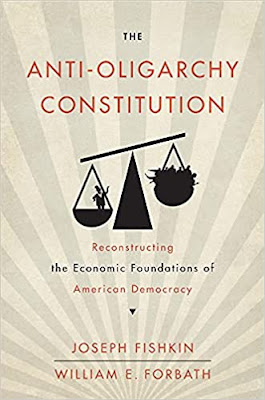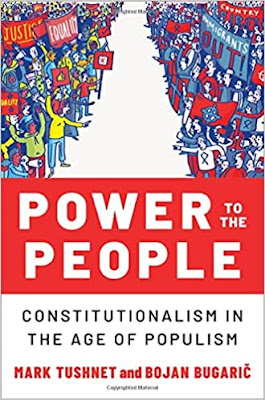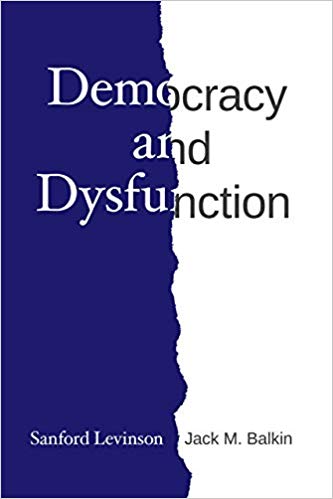Balkinization
an unanticipated consequence of
Jack M. Balkin
Balkinization Symposiums: A Continuing List
E-mail:
Jack Balkin:
jackbalkin at yahoo.com
Bruce Ackerman
bruce.ackerman at yale.edu
Ian Ayres
ian.ayres at yale.edu
Corey Brettschneider
corey_brettschneider at brown.edu
Mary Dudziak
mary.l.dudziak at emory.edu
Joey Fishkin
joey.fishkin at gmail.com
Heather Gerken heather.gerken at yale.edu
Abbe Gluck abbe.gluck at yale.edu
Mark Graber
mgraber at law.umaryland.edu
Stephen Griffin
sgriffin at tulane.edu
Jonathan Hafetz
jonathan.hafetz at shu.edu
Jeremy Kessler
jkessler at law.columbia.edu
Andrew Koppelman
akoppelman at law.northwestern.edu
Marty Lederman
msl46 at law.georgetown.edu
Sanford Levinson
slevinson at law.utexas.edu
David Luban
david.luban at gmail.com
Gerard Magliocca
gmaglioc at iupui.edu
Jason Mazzone
mazzonej at illinois.edu
Linda McClain
lmcclain at bu.edu
John Mikhail
mikhail at law.georgetown.edu
Frank Pasquale
pasquale.frank at gmail.com
Nate Persily
npersily at gmail.com
Michael Stokes Paulsen
michaelstokespaulsen at gmail.com
Deborah Pearlstein
dpearlst at yu.edu
Rick Pildes
rick.pildes at nyu.edu
David Pozen
dpozen at law.columbia.edu
Richard Primus
raprimus at umich.edu
K. Sabeel Rahmansabeel.rahman at brooklaw.edu
Alice Ristroph
alice.ristroph at shu.edu
Neil Siegel
siegel at law.duke.edu
David Super
david.super at law.georgetown.edu
Brian Tamanaha
btamanaha at wulaw.wustl.edu
Nelson Tebbe
nelson.tebbe at brooklaw.edu
Mark Tushnet
mtushnet at law.harvard.edu
Adam Winkler
winkler at ucla.edu
Compendium of posts on Hobby Lobby and related cases
The Anti-Torture Memos: Balkinization Posts on Torture, Interrogation, Detention, War Powers, and OLC
The Anti-Torture Memos (arranged by topic)
Recent Posts
AI, Privacy, and the Politics of Accountability Part 2: Privacy Harm in the AI Economy
Just A Few Blogs
ACS Blog
Alas, a Blog
Althouse
Arts and Letters Daily
Atrios (Eschaton)
Bill of Health
Buzzflash.com
Buzz Machine
Cato at Liberty
Juan Cole (Informed Comment)
Concurring Opinions
The Constitution in 2020
Corrente
Crooked Timber
Daily Howler
Daily Kos
Dana Boyd
Brad DeLong
Digby (Hullabaloo)
Discriminations
Daniel Drezner
Kevin Drum (Mother Jones)
Electrolite
En Banc
Eunomia (Daniel Larison)
Fafblog
Michael Froomkin (Discourse.net)
GovLab (Beth Noveck)
Rick Hasen (Election Law)
History News Network
How Appealing
Ignatz (Sam Heldman)
The Importance of (Ernie Miller)
Infolaw
Instapundit
International Economic Law and Policy Blog
IntLawGrrls
Jacob Levy
Jesus' General
Jurisdynamics
The Kitchen Cabinet
Mark Kleiman
Law Blog Central
Larry Lessig
Lawyers, Guns and Money
Liberal Oasis
Brian Leiter's Law School Reports
The Leiter Reports
Marginal Revolution
Megan McArdle
Memeorandum
Metafilter
Mirror of Justice
The New Republic
Newseum
No More Mister Nice Blog
Brendan Nyhan
Opinio Juris
Orcinus
The Originalism Blog
Pandagon
Passport (Foreign Policy)
Overcoming Bias
Political Animal (Washington Monthly)
Political Theory Daily Review
Political Wire (Taegan Goddard)
The Poor Man
Virginia Postrel
Prawfsblawg
Public Reason
Jonathan Rauch
Raw Story
Redstate
ReligiousLeftLaw.com
Reporters Committee For Freedom of the Press
Reproductive Rights Blog
Rothman's Roadmap to the Right of Publicity
SCOTUS Blog
Seeing the Forest
Clay Shirky
The Shifted Librarian
The Situationist
Larry Solum (Legal Theory)
Andrew Sullivan
Talking Points Memo
Talk Left
Tapped
Tbogg
TechPresident
The Paper Chase (Jurist)
Tom Paine
Tom Tomorrow (This Modern World)
Eve Tushnet
Uggabugga
University of Chicago Law School Faculty Blog
Unqualified Offerings
The Volokh Conspiracy
War and Piece (Laura Rozen)
Wampum
Oliver Willis
Wonkette
Written Description
Matthew Yglesias
Yin
Your Choice of Feeds
1. XML
powered by
2. Atom Feed
3. RSS 2.0
AI, Privacy, and the Politics of Accountability Part 2: Privacy Harm in the AI Economy
Guest Blogger
For the Balkinization Symposium on Ignacio Cofone, The Privacy Fallacy: Harm and Power in the Information Economy Cambridge University Press (2023). Ignacio Cofone [This first part of this response appeared yesterday as “AI, Privacy,
and the Politics of Accountability Part 1: Post-traditionalist Privacy for AI”] Privacy Harm
is Systemic Because Privacy is Relational Systemic harms relate to power asymmetries. Solow-Niederman
emphasizes the structural power imbalances inherent in the information economy,
a point echoed by Shvartzshnaider when discussing the opacity of data flows and
by Bietti when identifying surveillance as infrastructural. AI intensifies
these dynamics by enabling large-scale data aggregation and analysis that grow
power over those whose data is held. Governance frameworks must account for
these entrenched imbalances, as failure to do so risks perpetuating harms
masked by claims of neutrality in AI. For example, AI-powered credit scoring systems have been shown to
disproportionately deny loans to minority applicants, even when data on race is
excluded. This occurs through inferences such as those drawn from zip codes and
purchasing patterns. Guggenberger correctly indicated that “the difference
between product liability for cars and data lies in the type of harm.”
Products’ liability harm might be systematic, but it is not systemic. Shifting responsibility
from individuals whose data is being processed (where consent provisions place
it) to entities that process it responds to critiques that account for power. Doing
so requires advocating for governance models that recognize the systemic nature
of AI-driven harms. Haupt’s adaptation of the book’s framework to health privacy
illustrates the harm-related challenges introduced by AI. Consider the use of
AI in analyzing patient records to predict health risks. While beneficial,
these systems can inadvertently expose sensitive information, such as genetic
predispositions, to unauthorized parties through data breaches or
misconfigurations. Her distinction between professional and direct-to-consumer
applications of generative AI highlights the importance of context-adaptable
safeguards. In professional settings, there is a relationship of trust often
anchored in fiduciary duties but, in consumer relationships, even within healthcare,
reliance on an AI system often occurs without meaningful oversight or
accountability. Wearables and health apps show how non-sensitive data can
generate sensitive inferences, complicating traditional models. This leaves
regulatory compliance premised on faulty assumptions (such as the assumption
that deidentified data can’t be reidentified), and therefore ineffective at
preventing privacy harms from occurring. It therefore underscores the need for
systemic protections—such as information fiduciaries or liability frameworks
that account for the cumulative effects of AI-driven data processing. A focus
on systemic mechanisms, such as information fiduciaries or accountability for
(inferential) privacy harm, also accounts for political critiques such as Solow-Niederman’s,
since those mechanisms are designed to work independently of the behavior of
the powerless. Valuation Requires
Distinguishing Privacy Loss, Privacy Harm, and Consequential Harms A key aspect of making privacy harm work is its valuation, which Pasquale
highlighted. The challenge of assigning monetary value to privacy violations is
pronounced, particularly for relational data, as often is the case with AI.
Determining the harm caused by an algorithm’s biased decision-making, for example,
requires an understanding of both direct and downstream impacts. Harms are
often hidden in aggregated inferences, which complicate the valuation. Key to valuation is (a) distinguishing between (descriptive) privacy
losses and (normative) privacy harms and (b) recognizing that probabilistic
information (such as AI inferences) can be harmful absent material
consequences—two aspects that Zeide highlighted. For example, courts have
struggled to assign a value to harms caused by continued surveillance, such as
constant monitoring in the workplace, which erode wellbeing without immediate
material consequences. Key to untangling the situation is identifying that
people lose privacy with any amount of surveillance and their privacy is harmed
when such surveillance is exploitative, as continued surveillance often is,
separately from the material harms that such surveillance may produce. Zeide’s analysis of probabilistic privacy loss and harm also
captures the context-dependence of AI-driven data practices, where the same
data practice can become harmful in some situations and not in others because harms
arise from (probabilistic) inferences rather than direct disclosures of one
sensitive piece of information. For instance, the use of AI to infer health
risks from wearable device data can lead to insurance premium increases for
entire demographic groups, even if no specific individual’s data is explicitly
compromised. A framework for distinguishing privacy loss, harm, and
consequential damages provides a foundation for addressing these challenges
because it helps identify trade-offs. This intersects with Aggarwal’s analysis
of autonomy trade-offs in consumer finance, raising questions about the dual
impact of AI data processing. While AI data processing can enhance autonomy in
some situations, she explains, it can also undermine it, for example by
facilitating manipulation. And these harms extend beyond harms to autonomy. For
instance, dynamic pricing algorithms for necessary products, such as financial
instruments, often offer personalized discounts to some users while charging
others higher prices based not on their ability to pay but on their inferred need,
deepening inequality. Addressing trade-offs requires an analysis on probabilistic
information because (a) it highlights the non-binary nature of AI’s effects on
privacy and autonomy and (b) an approach to data practices grounded in
immaterial harms where not all privacy losses are considered harmful offers a
framework for navigating these trade-offs. A dual remedial regime—combining private rights of action with
public enforcement—also aims to address valuation, as public enforcement avoids
the question of valuation by decoupling sanctions and compensation. Pasquale’s comment
underscores the need for additional clarity on how these mechanisms can be
coordinated to ensure both deterrence and redress—concerns that resonate with
Bietti’s critique of ex-post models. I would suggest, as I mentioned above,
that hybrid approaches that integrate valuation tools into liability frameworks
and complement them with valuation-independent regulatory oversight are an
improvement over the alternative. This does imply, however, as Zeide states, “not
simply asking for courts to apply law to specific facts, but to make normative
choices about legitimate and highly contested values.” So, as Bietti notes,
civil liability mechanisms imply delegating some amount of power to courts (as
do information fiduciaries). And, depending on the institutional and political
context, doing so could have significant drawbacks. It implies more than ever
that regulating privacy means shifting power. As Kaminski notes, “who
interprets the law, who negotiates, develops, and changes its meaning” matters. Methods of
Valuation Can be Taken from Longstanding Doctrine This leads to the central challenge that
Pasquale brings: “what methods of valuation might best ensure just remedies for
wronged data subjects?” I believe that two methods hold promise—and which holds
most promise will depend on each jurisdiction. Two doctrinal categories that capture
the notion of privacy harm as exploitation are dignitary harms and emotional
harm suffered by a reasonable person. The first way to categorize privacy harm is
as dignitary harm. Privacy harm interferes with data subjects’ dignity because privacy
harm is a form of instrumentalization, and not being instrumentalized has long
been considered an aspect of human dignity. In it, data subjects are exploited
by treating them as a means for self-serving ends (including the end of making
a profit) rather than as ends in themselves. Disregarding the negative effects
of profitable data practices on data subjects constitutes an affront to their
dignity: the intrinsic worth of data subjects is disrespected when profit is
made at the expense of their increased risk of material harm. The dignitary harms categorization fits well
in continental European civil law frameworks, which have a history of relating
privacy to dignity. The GDPR’s fairness requirement, moreover, adds support to
the idea that this form of exploitation is a legal dignitary harm in the EU.
This is because the principle states that personal data must be used in a way
that is fair, in the sense of using it in ways that people reasonably expect
and not in ways that have unjustified adverse effects. Under this first
doctrinal approach, privacy harm is inflicted when someone is treated as a
means to an end for making profit at their expense. The corollary is that,
under this doctrinal category, national courts should grant the compensation
amounts that they can grant for dignitary harm particularly, but not solely,
under national law. The European Court of Human Rights, for example, has developed
case law on nonpecuniary harms for privacy claims against state actors. The
court, focused on the dignitary (non-material) value of privacy, awarded
nonpecuniary dignity-based damages with an average individual amount of €16,000
in approximately two-thirds of the cases where it found a privacy violation, in
addition to granting material damages. For this first form of privacy harm
compensation, courts could grant the quantum they would consider appropriate
for other forms of dignitary harm. The second way to categorize privacy harm
under national laws is the emotional harm that would have been suffered by a hypothetical
reasonable person. This categorization might fit most common law jurisdictions.
The UK case Vidal-Hall, for example, recognized
this doctrinal way to categorize non-material privacy harm, emotional harm
suffered by a reasonable person, showing how it can also fit doctrinal
categories under national laws of Member States. In most European civil law
jurisdictions, courts seem to retain freedom to apply both dignitary harm and
emotional harm. Under this second
doctrinal category, damages for privacy harm should be quantified in the same
way that national courts would quantify other emotional harm suffered by a
reasonable person. Courts across
jurisdictions have recognized that emotional distress is sufficient to
establish harm in non-digital contexts. Others before me have argued
that data breaches yield an amount of emotional distress analogous to
the distress that courts otherwise recognize as harmful. The corollary
to this second doctrinal approach would be to grant each person amounts that
courts in that jurisdiction have granted in cases of (non-privacy) emotional
distress. This method allows for quantification efforts to fall under common practices
in national case law. Common law
courts, for example, have awarded as much as $100,000 for such emotional
distress claims in some jurisdictions. Alternatively,
national courts can base this compensation on other forms of intangible harm for
which they have precedent, such as those for assault and battery. This
emotional harm should be determined objectively—not as the emotional harm
subjectively felt by each person. With either the dignity or the emotional harm
approach, therefore, a court could base compensation amounts on national
precedent in a way that captures immaterial harm objectively. Conclusion
I’m enormously thankful to the symposium contributors for their
engagement with the arguments in The Privacy Fallacy. Their reflections bring
out important challenges in governance, institutional design, and political
economy, particularly for AI. I trust that the points made in the different symposium
comments will spark some further discussion on how to address privacy harm and other
data harms. And I hope that, with several of us thinking about how to develop
accountability frameworks for AI anchored in social values such as privacy, we might
have a regulatory regime that encourages socially beneficial innovation while
keeping people safe. Ignacio Cofone is Professor of Law and Regulation of AI at Oxford University. You can reach him by e-mail at ignacio.cofone@law.ox.ac.uk.
Posted
9:30 AM
by Guest Blogger [link]
Books by Balkinization Bloggers

Linda C. McClain and Aziza Ahmed, The Routledge Companion to Gender and COVID-19 (Routledge, 2024)

David Pozen, The Constitution of the War on Drugs (Oxford University Press, 2024)

Jack M. Balkin, Memory and Authority: The Uses of History in Constitutional Interpretation (Yale University Press, 2024)

Mark A. Graber, Punish Treason, Reward Loyalty: The Forgotten Goals of Constitutional Reform after the Civil War (University of Kansas Press, 2023)

Jack M. Balkin, What Roe v. Wade Should Have Said: The Nation's Top Legal Experts Rewrite America's Most Controversial Decision - Revised Edition (NYU Press, 2023)

Andrew Koppelman, Burning Down the House: How Libertarian Philosophy Was Corrupted by Delusion and Greed (St. Martin’s Press, 2022)

Gerard N. Magliocca, Washington's Heir: The Life of Justice Bushrod Washington (Oxford University Press, 2022)

Joseph Fishkin and William E. Forbath, The Anti-Oligarchy Constitution: Reconstructing the Economic Foundations of American Democracy (Harvard University Press, 2022)

Mark Tushnet and Bojan Bugaric, Power to the People: Constitutionalism in the Age of Populism (Oxford University Press 2021).

Mark Philip Bradley and Mary L. Dudziak, eds., Making the Forever War: Marilyn B. Young on the Culture and Politics of American Militarism Culture and Politics in the Cold War and Beyond (University of Massachusetts Press, 2021).

Jack M. Balkin, What Obergefell v. Hodges Should Have Said: The Nation's Top Legal Experts Rewrite America's Same-Sex Marriage Decision (Yale University Press, 2020)

Frank Pasquale, New Laws of Robotics: Defending Human Expertise in the Age of AI (Belknap Press, 2020)

Jack M. Balkin, The Cycles of Constitutional Time (Oxford University Press, 2020)

Mark Tushnet, Taking Back the Constitution: Activist Judges and the Next Age of American Law (Yale University Press 2020).

Andrew Koppelman, Gay Rights vs. Religious Liberty?: The Unnecessary Conflict (Oxford University Press, 2020)

Ezekiel J Emanuel and Abbe R. Gluck, The Trillion Dollar Revolution: How the Affordable Care Act Transformed Politics, Law, and Health Care in America (PublicAffairs, 2020)

Linda C. McClain, Who's the Bigot?: Learning from Conflicts over Marriage and Civil Rights Law (Oxford University Press, 2020)

Sanford Levinson and Jack M. Balkin, Democracy and Dysfunction (University of Chicago Press, 2019)

Sanford Levinson, Written in Stone: Public Monuments in Changing Societies (Duke University Press 2018)

Mark A. Graber, Sanford Levinson, and Mark Tushnet, eds., Constitutional Democracy in Crisis? (Oxford University Press 2018)

Gerard Magliocca, The Heart of the Constitution: How the Bill of Rights became the Bill of Rights (Oxford University Press, 2018)

Cynthia Levinson and Sanford Levinson, Fault Lines in the Constitution: The Framers, Their Fights, and the Flaws that Affect Us Today (Peachtree Publishers, 2017)

Brian Z. Tamanaha, A Realistic Theory of Law (Cambridge University Press 2017)

Sanford Levinson, Nullification and Secession in Modern Constitutional Thought (University Press of Kansas 2016)

Sanford Levinson, An Argument Open to All: Reading The Federalist in the 21st Century (Yale University Press 2015)

Stephen M. Griffin, Broken Trust: Dysfunctional Government and Constitutional Reform (University Press of Kansas, 2015)

Frank Pasquale, The Black Box Society: The Secret Algorithms That Control Money and Information (Harvard University Press, 2015)

Bruce Ackerman, We the People, Volume 3: The Civil Rights Revolution (Harvard University Press, 2014)
Balkinization Symposium on We the People, Volume 3: The Civil Rights Revolution

Joseph Fishkin, Bottlenecks: A New Theory of Equal Opportunity (Oxford University Press, 2014)

Mark A. Graber, A New Introduction to American Constitutionalism (Oxford University Press, 2013)

John Mikhail, Elements of Moral Cognition: Rawls' Linguistic Analogy and the Cognitive Science of Moral and Legal Judgment (Cambridge University Press, 2013)

Gerard N. Magliocca, American Founding Son: John Bingham and the Invention of the Fourteenth Amendment (New York University Press, 2013)

Stephen M. Griffin, Long Wars and the Constitution (Harvard University Press, 2013)

Andrew Koppelman, The Tough Luck Constitution and the Assault on Health Care Reform (Oxford University Press, 2013)

James E. Fleming and Linda C. McClain, Ordered Liberty: Rights, Responsibilities, and Virtues (Harvard University Press, 2013)
Balkinization Symposium on Ordered Liberty: Rights, Responsibilities, and Virtues

Andrew Koppelman, Defending American Religious Neutrality (Harvard University Press, 2013)

Brian Z. Tamanaha, Failing Law Schools (University of Chicago Press, 2012)

Sanford Levinson, Framed: America's 51 Constitutions and the Crisis of Governance (Oxford University Press, 2012)

Linda C. McClain and Joanna L. Grossman, Gender Equality: Dimensions of Women's Equal Citizenship (Cambridge University Press, 2012)

Mary Dudziak, War Time: An Idea, Its History, Its Consequences (Oxford University Press, 2012)

Jack M. Balkin, Living Originalism (Harvard University Press, 2011)

Jason Mazzone, Copyfraud and Other Abuses of Intellectual Property Law (Stanford University Press, 2011)

Richard W. Garnett and Andrew Koppelman, First Amendment Stories, (Foundation Press 2011)

Jack M. Balkin, Constitutional Redemption: Political Faith in an Unjust World (Harvard University Press, 2011)

Gerard Magliocca, The Tragedy of William Jennings Bryan: Constitutional Law and the Politics of Backlash (Yale University Press, 2011)

Bernard Harcourt, The Illusion of Free Markets: Punishment and the Myth of Natural Order (Harvard University Press, 2010)

Bruce Ackerman, The Decline and Fall of the American Republic (Harvard University Press, 2010)
Balkinization Symposium on The Decline and Fall of the American Republic

Ian Ayres. Carrots and Sticks: Unlock the Power of Incentives to Get Things Done (Bantam Books, 2010)

Mark Tushnet, Why the Constitution Matters (Yale University Press 2010)
Ian Ayres and Barry Nalebuff: Lifecycle Investing: A New, Safe, and Audacious Way to Improve the Performance of Your Retirement Portfolio (Basic Books, 2010)
.jpg)
Jack M. Balkin, The Laws of Change: I Ching and the Philosophy of Life (2d Edition, Sybil Creek Press 2009)

Brian Z. Tamanaha, Beyond the Formalist-Realist Divide: The Role of Politics in Judging (Princeton University Press 2009)

Andrew Koppelman and Tobias Barrington Wolff, A Right to Discriminate?: How the Case of Boy Scouts of America v. James Dale Warped the Law of Free Association (Yale University Press 2009)

Jack M. Balkin and Reva B. Siegel, The Constitution in 2020 (Oxford University Press 2009)
Heather K. Gerken, The Democracy Index: Why Our Election System Is Failing and How to Fix It (Princeton University Press 2009)

Mary Dudziak, Exporting American Dreams: Thurgood Marshall's African Journey (Oxford University Press 2008)

David Luban, Legal Ethics and Human Dignity (Cambridge Univ. Press 2007)

Ian Ayres, Super Crunchers: Why Thinking-By-Numbers is the New Way to be Smart (Bantam 2007)

Jack M. Balkin, James Grimmelmann, Eddan Katz, Nimrod Kozlovski, Shlomit Wagman and Tal Zarsky, eds., Cybercrime: Digital Cops in a Networked Environment (N.Y.U. Press 2007)

Jack M. Balkin and Beth Simone Noveck, The State of Play: Law, Games, and Virtual Worlds (N.Y.U. Press 2006)

Andrew Koppelman, Same Sex, Different States: When Same-Sex Marriages Cross State Lines (Yale University Press 2006)
Brian Tamanaha, Law as a Means to an End (Cambridge University Press 2006)
Sanford Levinson, Our Undemocratic Constitution (Oxford University Press 2006)
Mark Graber, Dred Scott and the Problem of Constitutional Evil (Cambridge University Press 2006)
Jack M. Balkin, ed., What Roe v. Wade Should Have Said (N.Y.U. Press 2005)
Sanford Levinson, ed., Torture: A Collection (Oxford University Press 2004)
Balkin.com homepage
Bibliography
Conlaw.net
Cultural Software
Writings
Opeds
The Information Society Project
BrownvBoard.com
Useful Links
Syllabi and Exams